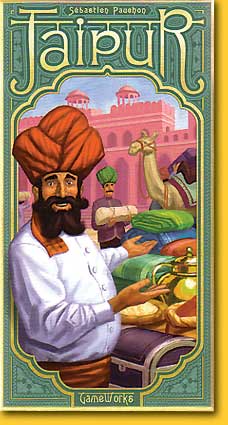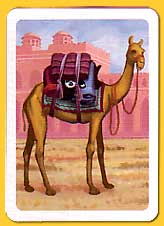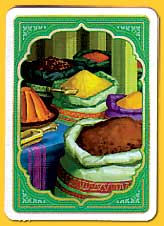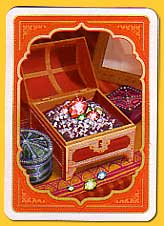Jaipur
Author: Sébastien Pauchon
Publisher: Gameworks
Year: 2009
review by

| x |
|
|
|
|
|
|
|
|
|
|
|
|
|
|
|
|
|
|
|
|
|
|
|
|
|
|
|
|
|
|
|
|
|
|
|
|
|
|
|
|
|
|
|
|
|
|
 |
The market of Jaipur is a lively place, littered with numerous stands containing silk, spices, silver and other trinkets. Trade is booming, traders are shouting at the top of their lungs to advertise their goods. The richest merchant will receive the honour of becoming the Maharaja's personal trader, a highly desirable position! We can obtain goods by exchange on the market, a transaction with a very important role for the ever-popular camel. Subsequently, we sell the goods for hard cash. Very lucrative exchanges even yield bonuses! At the end of the week, the merchant with the highest amount of rupees is awarded a prestigious seal. The first player to earn his second seal is appointed as the Maharaja's personal trader, and wins the game.
|
|
| x |
|
|
|
|
|
|
|
|
|
|
|
|
|
|
|
|
|
|
|
|
|
|
|
|
|
|
|
|
|
|
|
|
|
|
|
|
|
|
|
|
|
|
|
|
|
|
|
 
|
|
The card deck consists of six different kinds (colours) of goods, and camels. The market where the players can obtain their cards is composed of five cards. In a player's turn, a player may either take cards from the market, or sell cards for rupees. |
|
| x |
|
|
|
|
|
|
|
|
|
|
|
|
|
|
|
|
|
|
|
|
|
|
|
|
|
|
|
|
|
|
|
|
|
|
|
|
|
|
|
|
|
|
|
|
|
|
|
When taking cards from the market, the player has three options:
- take one goods card from the market, and restock the market from the drawing pile
- take multiple goods cards from the market, and restock the market with goods cards from his own hand, or camel cards from his own herd
- take all camel cards from the market, and restock the market from the drawing pile.
A payer may not possess more than seven cards. All camel cards the players obtain are immediately placed in front of them, forming their herd. The camel cards therefore do not count toward the seven-card limit.
|
|
| x |
|
|
|
|
|
|
|
|
|
|
|
|
|
|
|
|
|
|
|
|
|
|
|
|
|
|
|
|
|
|
|
|
|
|
|
|
|
|
|
|
|
|
|
|
|
|
 |
|
When selling goods, the player plays as many cards of the same colour as he wants, and takes the same number of goods tokens of the same colour. The goods tokens have different values; the tokens with the highest values are positioned on top, and will therefore be distributed first. If a player sells three, four or five goods, he receives a bonus token in addition to the goods tokens. |
|
| x |
|
|
|
|
|
|
|
|
|
|
|
|
|
|
|
|
|
|
|
|
|
|
|
|
|
|
|
|
|
|
|
|
|
|
|
|
|
|
|
|
|
|
|
|
|
|
|
The week has ended when either three out of six piles of goods tokens are depleted, or the market can no longer be restocked because the drawing pile is finished. Both players add up the values of all their goods tokens and bonus tokens, and the richest player receives a seal. As soon as a player earns his second seal, the game is over.
|
|
| x |
|
|
|
|
|
|
|
|
|
|
|
|
|
|
|
|
|
|
|
|
|
|
|
|
|
|
|
|
|
|
|
|
|
|
|
|
|
|
|
|
|
|
|
|
|
|
|
|
| x |
|
|
|
|
|
|
|
|
|
|
|
|
|
|
|
|
|
|
|
|
|
|
|
|
|
|
|
|
|
|
|
|
|
|
|
|
|
|
|
|
|
|
|
|
|
|
| x |
|
|
|
|
|
|
|
|
|
|
|
|
|
|
|
|
|
|
|
|
|
|
|
|
|
|
|
|
|
|
|
|
|
|
|
|
|
|
|
|
|
|
|
|
|
|
| x |
|
|
|
|
|
|
|
|
|
|
|
|
|
|
|
|
|
|
|
|
|
|
|
|
|
|
|
|
|
|
|
|
|
|
|
|
|
|
|
|
|
|
|
|
|
|
 |
|
|
|
|
|
|
|
|
|
|
|
|
|
|
|
|
|
|
|
|
|
|
|
|
|
|
|
|
|
|
|
|
|
|
|
|
|
|
|
|
|
|
|
The material leaves nothing to be desired: the cards are beautifully illustrated with bright, easily distinguishable colours that also nicely match the colours of the corresponding goods tokens. Also the mechanism of Jaipur is very sound.
|
|
| x |
|
|
|
|
|
|
|
|
|
|
|
|
|
|
|
|
|
|
|
|
|
|
|
|
|
|
|
|
|
|
|
|
|
|
|
|
|
|
|
|
|
|
|
|
|
|
| When a player wants to collect many cards in one turn, he has to restock the market with his own goods or camels, while when drawing only one card, the market is conveniently restocked from the drawing pile. But with one card at the time, it will take a couple of turns to collect all the desired cards, and the opponent may be after the same cards. If both players want to sell the same type of goods, the most valuable goods tokens will go to the player who sells first. For some goods, the value of the tokens drops quickly, so it can be more profitable to sell a small number of goods for a high price, than to collect and sell multiple cards in order to obtain an additional bonus token. |
 |
|
| x |
|
|
|
|
|
|
|
|
|
|
|
|
|
|
|
|
|
|
|
|
|
|
|
|
|
|
|
|
|
|
|
|
|
|
|
|
|
|
|
|
|
|
|
|
|
|
  |
|
You are constantly watching your opponent: which goods is he collecting, does he have enough camels as 'exchange money', is his card limit almost reached so that he has to sell goods instead of taking cards in his next turn, et cetera. |
|
| x |
|
|
|
|
|
|
|
|
|
|
|
|
|
|
|
|
|
|
|
|
|
|
|
|
|
|
|
|
|
|
|
|
|
|
|
|
|
|
|
|
|
|
|
|
|
|
This makes Jaipur a very interactive and strategic game, and yet it is so simple that it can be explained within a couple of minutes, and played within thirty minutes.
© 2009 Barbara van Vugt
Jaipur, Sébastien Pauchon, Gameworks, 2009 - 2 players, 12 years and up, 30 minutes
|
|
  |
|
|
|
|
|
|
|
|
|
|
|
|
|
|
|
|
|
|
|
|
|
|
|
|
|
|
|
|
|
|
|
|
|
|
|
|
|
|
|
|
|
|
  |
Effortlessly joins the 'Hall Of Fast To Play Quality Two Player Card Games' |
|
| x |
|
|
|
|
|
|
|
|
|
|
|
|
|
|
|
|
|
|
|
|
|
|
|
|
|
|
|
|
|
|
|
|
|
|
|
|
|
|
|
|
|
|
|
|
|
|
| x |
|
|
|
|
|
|
|
|
|
|
|
|
|
|
|
|
|
|
|
|
|
|
|
|
|
|
|
|
|
|
|
|
|
|
|
|
|
|
|
|
|
|
|
|
|
|
 |
|
|
|
|
|
|
|
|
|
|
|
|
|
|
|
|
|
|
|
|
|
|
|
|
|
|
|
|
|
|
|
|
|
|
|
|
|
|
|
|
|
|
 |
|
|
|
|
|
|
|
|
|
|
|
|
|
|
|
|
|
|
|
|
|
|
|
|
|
|
|
|
|
|
|
|
|
|
|
|
|
|
|
|
|
|
| x |
|
|
|
|
|
|
|
|
|
|
|
|
|
|
|
|
|
|
|
|
|
|
|
|
|
|
|
|
|
|
|
|
|
|
|
|
|
|
|
|
|
|
|
|
|
|
 |
|
|
|
|
|
|
|
|
|
|
|
|
|
|
|
|
|
|
|
|
|
|
|
|
|
|
|
|
|
|
|
|
|
|
 |
|
|
|
|
|
|
|
|
|
|
|
|
|
|
|
|
|
|
|
|
|
|
|
|
|
|
|
|
|
|
|
|
|
|
|
|